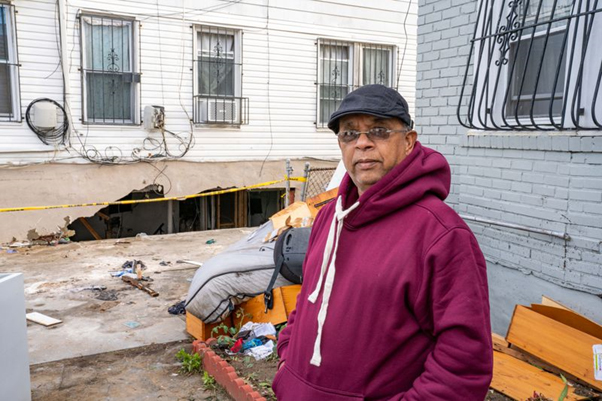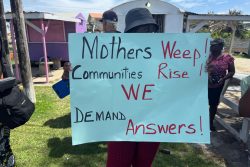 Statues of seated lions guard the gates of the modest Colonial-style house with the small portico. Beyond the fleur-de-lis finials on the black wrought iron fence, the squashed marigolds still offer a brave bit of colour from the tiny strip of a garden.
Statues of seated lions guard the gates of the modest Colonial-style house with the small portico. Beyond the fleur-de-lis finials on the black wrought iron fence, the squashed marigolds still offer a brave bit of colour from the tiny strip of a garden.
But the stark notice on the door and the police caution tape, left a week ago, indicate this property is being treated as a crime scene.
The dwelling was built in 1920, like several others along 183rd Street in Hollis, Queens, as a single family residence with three bedrooms and a bath. Reportedly, a drainage basin where a creek once flowed, was filled in. The structure had started life as a cosy home for the White emerging middle-class workers, anxious to move away from the teeming tenements of New York.
Historically a collection of small towns and villages founded by the Dutch, the city’s most extensive borough has exploded with a rising population of over 2.4 million, only behind Brooklyn, crammed into a vulnerable area totalling just 178 square miles (460 km2), nearly two fifths of which is water.
In time, as demographics shifted yet again and the descendants of the original owners sold and moved on as incomes rose, hopeful new immigrants of all colours and cultures and from all countries, continued to flow into the United States of America, many drawn, as always, to the magnetic City of Dreams. One such arrival was Guyanese, Ragendra Shivprasad who would finally save enough money to pay down on the house numbered 90-11, which went for US$325,000 in 2002, and is worth two and half times that now, according to online records.
“The rain – it’s rain and rain and rain and more rain,” he recalled of what happened last week Wednesday night, when the remnants of Hurricane Ida slammed into the city’s aging infrastructure with record water levels from climate change – and tragic results.
Mr Shivprasad had quietly and gradually developed the basement of the house without any official approval, joining thousands of property owners, looking for a little extra income in one of the most expensive and demanding housing markets in the world.
Eventually, he rented it to a Trinidadian immigrant family, the Ramskriets, who chose to stay in the cheaper housing option, since they depended on a single income, while raising two children. The families had grown close over the decade and a half, becoming friends and living like relatives, checking each other and Uncle “Raj” nearly daily.
“As I see the water raising (rising) I go back, I tell them, ‘You guys gotta be careful, you guys gotta move,’” Mr Shivprasad related to the Post newspaper. “You guys gotta get out from there. The water is raising (rising),” he urged. Four feet of racing flood waters crashed through an upper section of the basement, pouring in and trapping Prematti “Tara” Ramskriet, 43, and her older son Nicholas known as “Nick” or Krishnah Ramskriet, 22, who had been trying to grab important documents and other valuables. Nicholas was preparing for college.
The water had initially reached their ankles when the surprised four rushed to retrieve a few things. Suddenly, they heard what sounded like a collapse, surviving son Dylan told the New York Times (NYT), and a rush of water shoved them through the pitch-black apartment that Mrs Ramskriet had turned into a beautiful home. The torrent swept the father, Dameshwar, as he desperately clutched the hand of his beloved Tara. “I tried to hold on to my wife, and she was trying to hold on to me,” the distraught man recounted hours later. He began to cry. “But the water pushed me away and I couldn’t feel her hand anymore.” He lost everything.
A nearby neighbour, Mahen Singh, who shot and shared footage of the floods, revealed to CBS New York, “I was standing on the porch…the wall broke open and the water started gushing down.” Horrified, he watched the flash floods rapidly heighten. “Next thing, I heard a loud scream… It was devastating. I was right out here, I watched the whole thing… Nobody could even help them.”
There are a minimum of 50,000 basements that have been illegally converted to dwellings for thousands of New Yorkers, including unknown numbers of undocumented aliens, according to conservative estimates. At least 11 of the 13 people known to have died due to Hurricane Ida were trapped in such units in Queens and Brooklyn.
“At least 100,000 people — and there’s a strong possibility there’s a lot more — are living in those apartments,” Mayor Bill de Blasio, a Democrat, said. “So many people who end up in the illegal basements are fearful to communicate for fear they might be evicted or, worse in their mind, deported,” he acknowledged. However, some housing advocates believe there is potentially thrice this number literally living underground in basements and cellars.
Executive Director of the Chhaya community development group, Annetta Seecharran has long called for the city to address the housing crisis and to help errant landlords bring their unauthorised hidden rentals up to code. “We need to bring basement apartments out of the shadows and into the light,” the Guyanese-born Ms. Seecharran declared in an NYT interview.
After the storm, the City’s Buildings Commissioner Melanie La Rocca sent out inspectors to check more than a thousand properties, including Mr Shivprasad’s. He and his family, including son, Amit Kumar, 39, who had dived in to save the Ramskriets, were forced to leave their home as officials pounced, serving notices of violations, and ordering the entire property vacated immediately. Citations were issued, too, to homeowners for creating unauthorised cellar living spaces that should have been reserved for “recreation, boiler and storage.”
An emotional Mr Shivprasad has become the public face of basement landlords caught in the catastrophe, vilified by some and defended by others, who blame the City’s authorities for not seeking to clean up and legalise the shadowy sector. He cried openly, as the media sought him for interviews, and apologised as he walked away. Amit maintained the tragedy was due to “Mother Nature.” Landlord “Uncle Raj” repeated he would have gladly died in the Ramskriets’ place, given his age of 71. A sewer pipe project undertaken by the city remains incomplete nearby, after years, residents complained.
On Sunday, as New Yorkers gathered for a vigil in Queens to remember the Ramskriets and those who had died, a community religious leader of the Arya Samaj movement, Dr Satish Prakash expressed support for Mr Shivprasad, who stood next to him. “This gentleman was not a criminal, there was a need for him to have people in the basement, since many “can’t find homes,” Dr Prakash insisted.
The surviving Ramskriets are staying with Tara’s sister Seromanie “Sally” Gobin, who has organised a GoFundMe effort, raising over US$37 000 by yesterday, for the funerals and living expenses.
“Tara was a loving wife and mother. Family oriented” and in turn she “was loved by everyone” as a “kind, caring, helpful and a very humble person. She was the light of our lives.” Nick “had an amazing personality, very outgoing, full of laughter and was always up for an adventure.”
Outside of Lot 90-11, 183rd Street, a few of the shadows from the fence’s metal lilies scatter on the door’s sun-lit City notice, as the yellow tape flutters in the wind.
ID records this response from a NYT reader: “I lived on that very block in the 1970s. We were flooded many times. We lost everything several times over. My parents finally had enough and left in 1985. The city knows this place has always had a problem. They did nothing…”










